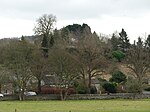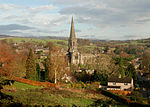Burton Closes

Burton Closes is a 19th-century country house, now in use as a residential nursing home, situated at Haddon Road, Bakewell, Derbyshire. It is a Grade II* listed building. The house was newly built in 1848 for John Allcard, a wealthy Quaker banker and stockbroker of Derby. It was originally built as a modest two bedroomed house, to a design by architect Joseph Paxton with interiors by Augustus Pugin and intended as a summer retreat. It was much extended by T D Barry and E W Pugin in 1856 for Allcard's son William, a railway engineer, best known for his 1830 work on the Sankey Viaduct, Warrington, Cheshire, where he was mayor in 1848 and 1851. The Allcard family fortunes were much reduced by a financial downturn in 1866 and 1871 (when William Henry Allcard, a barrister, sold the estate). Further improvements and extensions were made in 1888 by J B Mitchell Withers for the purchaser Smith Taylor-Whithead, who was High Sheriff of Derbyshire in 1894.
Excerpt from the Wikipedia article Burton Closes (License: CC BY-SA 3.0, Authors, Images).Burton Closes
Burton Close Drive, Derbyshire Dales
Geographical coordinates (GPS) Address Nearby Places Show on map
Geographical coordinates (GPS)
| Latitude | Longitude |
|---|---|
| N 53.2056 ° | E -1.6713 ° |
Address
Burton Close Drive
Burton Close Drive
DE45 1BG Derbyshire Dales
England, United Kingdom
Open on Google Maps











